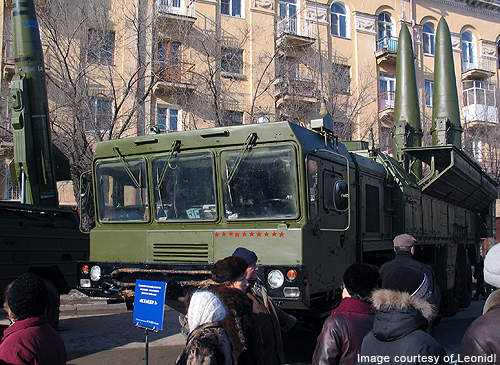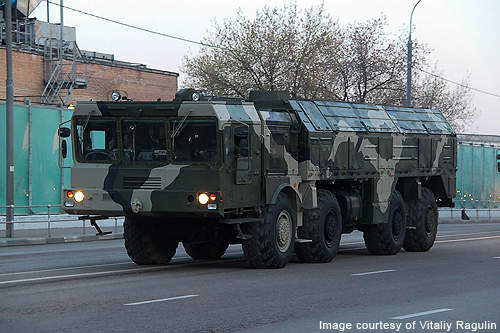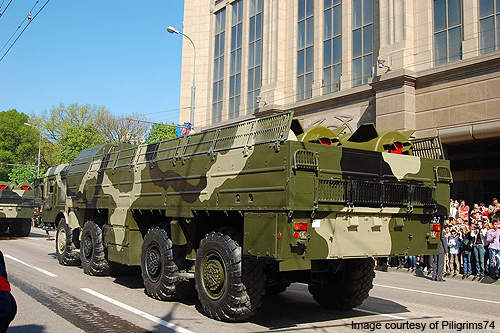The Iskander (Nato: SS-26 Stone) is a tactical ballistic missile system being manufactured by the Federal State Unitary Enterprise, Design Bureau of Machine Building, for the Russian ground forces. Iskander missiles were first test fired in 1996. The Russian Army acquired the Iskander-M extended-range ballistic missile system in 2006.
The Iskander mobile missile system can engage ground targets such as command posts and communications nodes, troops in concentration areas, air and missile defence facilities, as well as fixed and rotary-wing aircraft at airfields.
The Iskander was developed in the 1990s to replace the decommissioned OTR-23 Oka (Nato: SS-23) missile system. Oka was retired from Russian service under the 1987 intermediate nuclear forces (INF) treaty.
Orders and deliveries of the Iskander ballistic missile system
Russia acquired six Iskander systems in 2010. The first system was deployed in the Western Military District.
The Russian Defence Ministry plans to buy up to 120 Iskander-M tactical missile systems to equip at least ten missile brigades of Iskander-M complexes by 2017.
Belarus, Iran and Libya have also expressed interest in procuring Iskander missiles.
Iskander-E export ballistic missile system
The Iskander missile system is produced in three variants. Iskander-E is an export version designed to meet the guidelines of MTCR (missile technology control regime). It has a maximum firing range of 280km and circular error probable (CEP) of 30m to 70m. It is also equipped with an inertial guidance system.
Iskande-M extended-range missile system
Iskander-M is an extended range missile developed for the Russian Army. The missile has an expected range of more than 400km. It is equipped with inertial and optical guidance systems for improved firing accuracy, and an electro-optical seeker for self-homing capabilities.
Iskander-K cruise missile system
Iskander-K is the latest variant in the Iskander series of missiles. The missile system is equipped with R-500 cruise missile. It was first test fired from the mobile Iskander platform in May 2007. It attained a speed of approximately 250m a second at altitudes of 100m.
Iskander missile system features
The Iskander missile system is equipped with two independently targeted short-range ballistic missiles. Each missile has a length of 7.3m, body diameter of 0.92m and weight of 3,800kg. The missile can be re-targeted during flight to engage moving targets.
Iskander can carry 480kg of conventional warheads including HE fragmentation, submunition, penetration, fuel-air explosive and electro-magnetic pulse. The minimum firing range of the missile is 50km and the maximum is 280km. Iskander is powered by a single-stage solid-propellant engine.
The Iskander-M is equipped with a self-contained inertial navigation system (INS) and an optically guided warhead. The optical homing head can also be controlled from an airborne warning and control system (AWACS) or an unmanned aerial vehicle (UAV). This feature provides a self-homing capability to the missile. Targets can be identified by satellite, aircraft, conventional intelligence centre or a soldier. After receiving the images of the target, the onboard computer of the missile locks onto the target with its sight and directs the warhead towards the target at supersonic speed.
The missile can overcome enemy air defence systems while offering high-probability of failure-free operation in countermeasures environments. It has a target accuracy of 5m to 7m and operates even in fog or low visibility.
Launch vehicle for the tactical ballistic missile system
The transport-erector-launcher (TEL) vehicle based on the MZKT-7930 Astrolog 8×8 chassis carries two Iskander missiles.
The TEL is powered by a YaMZ-846 diesel engine delivering a power output of 500hp. The vehicle is equipped with full nuclear, biological and chemical (NBC) protection systems. Four hydraulic jack supports on the vehicle enable the positioning of the TEL on uneven land within a short time. Missiles are raised to an angle of 85°, which takes around 20 seconds. The vehicle can be transported by an Antonov An-124 transport aircraft.
The Iskander TEL is supported by a transporter and loader vehicle built on the same 8×8 chassis. The vehicle can carry two reload missiles and a crane. The full Iskander missile system also comprises a command and control post vehicle, mission planning vehicle, maintenance and repair vehicle and a life support vehicle. These vehicles are based on KamAZ 43101 6×6 cargo truck chassis.
The Global Missiles and Missile Defence Systems Market 2011-2021
This project forms part of our recent analysis and forecasts of the global missiles and missile defence systems market available from our business information platform Strategic Defence Intelligence. For more information click here or contact us: EMEA: +44 20 7936 6783; Americas: +1 415 439 4914; Asia Pacific: +61 2 9947 9709 or via email.







